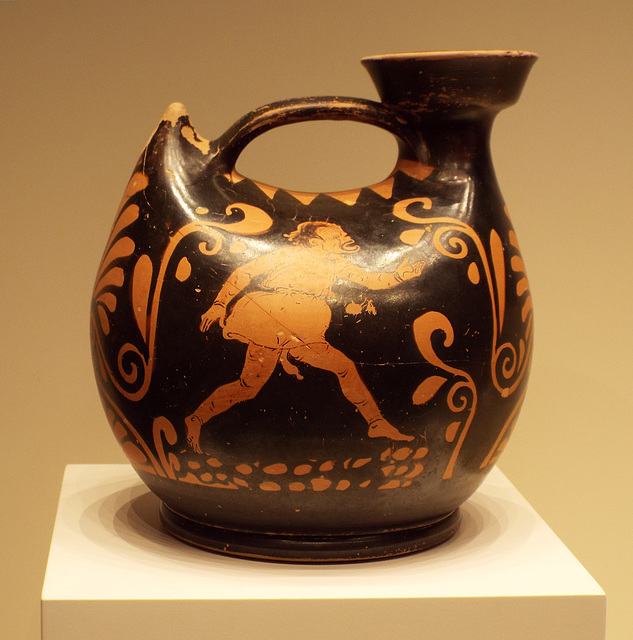South Italian Askos with a Comic Scene in the Gett…
Cycladic Storage Jar with a Pedestal Foot in the G…
Cycladic Storage Jar with a Pedestal Foot in the G…
Lekythos Attributed to the Circle of the Phiale Pa…
Lekythos Attributed to the Circle of the Phiale Pa…
Egyptian Lidded Baskets in the Getty Villa, June 2…
Egyptian Lidded Baskets in the Getty Villa, June 2…
Bronze Situla with Competing Athletes in the Getty…
Bronze Situla with Competing Athletes in the Getty…
Corinthian Pyxis with Animals in the Getty Villa,…
Corinthian Pyxis with Animals in the Getty Villa,…
Black-Figure Mastos Attributed to Psiax in the Get…
Black-Figure Mastos Attributed to Psiax in the Get…
Lekythos in the Form of a Sphinx in the Metropolit…
Lekythos in the Form of a Sphinx in the Metropolit…
Funerary Stele with Two Sphinxes in the Metropolit…
Funerary Stele with Two Sphinxes in the Metropolit…
Stemless Kylix with a Siren in the Metropolitan Mu…
Stemless Kylix with a Siren in the Metropolitan Mu…
Plaque with a Beautiful Scylla in the Metropolitan…
Plaque with a Beautiful Scylla in the Metropolitan…
Antefix with the Head of Medusa in the Metropolita…
Antefix with the Head of Medusa in the Metropolita…
Detail of a Portrait of a Woman as Cybele in the G…
Detail of a Portrait of a Woman as Cybele in the G…
Portrait of a Woman as Cybele in the Getty Villa,…
Portrait of a Woman as Cybele in the Getty Villa,…
Bronze Incense Burner in the Form of a Singer on a…
Bronze Incense Burner in the Form of a Singer on a…
Bronze Incense Burner in the Shape of a Comic Acto…
Bronze Incense Burner in the Shape of a Comic Acto…
Mycenaean Piriform Jar in the Getty Villa, June 20…
Mycenaean Piriform Jar in the Getty Villa, June 20…
Mycenaean Jug with a Man and a Bull in the Getty V…
Mycenaean Jug with a Man and a Bull in the Getty V…
Detail of a Statuette with an Inscribed Dedication…
Detail of a Statuette with an Inscribed Dedication…
Statuette with an Inscribed Dedication to the Etru…
Statuette with an Inscribed Dedication to the Etru…
Bronze Statuette of a Bugler in the Getty Villa, J…
Bronze Statuette of a Bugler in the Getty Villa, J…
Detail of a Kylix with Revelers in the Getty Villa…
Detail of a Kylix with Revelers in the Getty Villa…
Kylix with Revelers in the Getty Villa, June 2016
Kylix with Revelers in the Getty Villa, June 2016
See also...
Keywords
Authorizations, license
-
Visible by: Everyone -
All rights reserved
-
240 visits
South Italian Askos with a Comic Scene in the Getty Villa, June 2016


Title: Apulian Red-Figure Askos
Artist/Maker: Unknown
Culture: Greek (South Italian, Apulian)
Place: Apulia, South Italy, Europe (Place created)
Date: 360–350 B.C.
Medium: Terracotta
Object Number: 96.AE.114
Dimensions: 17 × 16 cm (6 11/16 × 6 5/16 in.)
Credit Line: Gift of Barbara and Lawrence Fleischman
Alternate Titles: Oil Vessel with a Comic Actor (Display Title)
Object Type: Askos
Vase-painters working in the Greek colonies in South Italy frequently depicted scenes connected with theatrical performances. Phlyax plays, popular in the 300s and 200s B.C., were farces parodying the heroes and themes of mythology or the comic elements of everyday life. The term phlyax, which is used for both the play and the costumed actors, probably derives from the Greek verb "to swell" and finds its meaning in the actors' costumes. They wore a mask, tights, a padded tunic, and a large artificial phallus; any other garments necessary for the role were worn over this.
Master and slave themes were popular in phlyax plays. On one side of this Apulian red-figure askos, a phlyax characterized as an older man runs along brandishing a stick. The other side shows a slave fleeing the beating.
The askos is a flask with a spout at one end and a handle across the top. This variant is called a duck askos because the back view resembles a duck's tail.
Text from: www.getty.edu/art/collection/objects/29524/unknown-maker-apulian-red-figure-askos-greek-south-italian-apulian-360-350-bc
Artist/Maker: Unknown
Culture: Greek (South Italian, Apulian)
Place: Apulia, South Italy, Europe (Place created)
Date: 360–350 B.C.
Medium: Terracotta
Object Number: 96.AE.114
Dimensions: 17 × 16 cm (6 11/16 × 6 5/16 in.)
Credit Line: Gift of Barbara and Lawrence Fleischman
Alternate Titles: Oil Vessel with a Comic Actor (Display Title)
Object Type: Askos
Vase-painters working in the Greek colonies in South Italy frequently depicted scenes connected with theatrical performances. Phlyax plays, popular in the 300s and 200s B.C., were farces parodying the heroes and themes of mythology or the comic elements of everyday life. The term phlyax, which is used for both the play and the costumed actors, probably derives from the Greek verb "to swell" and finds its meaning in the actors' costumes. They wore a mask, tights, a padded tunic, and a large artificial phallus; any other garments necessary for the role were worn over this.
Master and slave themes were popular in phlyax plays. On one side of this Apulian red-figure askos, a phlyax characterized as an older man runs along brandishing a stick. The other side shows a slave fleeing the beating.
The askos is a flask with a spout at one end and a handle across the top. This variant is called a duck askos because the back view resembles a duck's tail.
Text from: www.getty.edu/art/collection/objects/29524/unknown-maker-apulian-red-figure-askos-greek-south-italian-apulian-360-350-bc
- Keyboard shortcuts:
Jump to top
RSS feed- Latest comments - Subscribe to the comment feeds of this photo
- ipernity © 2007-2024
- Help & Contact
|
Club news
|
About ipernity
|
History |
ipernity Club & Prices |
Guide of good conduct
Donate | Group guidelines | Privacy policy | Terms of use | Statutes | In memoria -
Facebook
Twitter

Sign-in to write a comment.